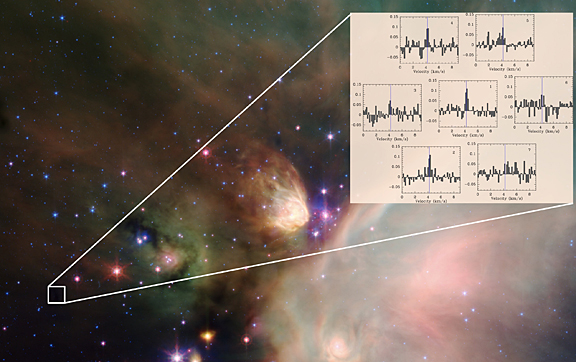Peering into the interior of a dark interstellar cloud

Rare molecular species like H2D+ and D2H+, built from the hydrogen atom H and its heavier isotope deuterium D, have gained great attention as probes of cold and dense molecular cloud cores. Since deuterium in space is about 100,000 times rarer than hydrogen, these molecules are very difficult to detect. Thanks to the conjunction of powerful instrumentation at APEX, the “Atacama Pathfinder EXperiment”, and an optimal site over 5,000 meters above sea level, a research team from the Max Planck Institute for Radio Astronomy in Bonn led by Berengere Parise was able to map the spatial distribution of the rare D2H+ species in a prestellar core in the Rho Ophiuchi cloud, a star-forming region at a distance of approximately 400 light-years.
Stars form in clouds of dust and gas. Before the birth of the star, these clouds are dense and extremely cold (temperatures of about 10 Kelvin, corresponding to approximately -260 degrees Celsius), causing most of the gaseous molecules to be frozen on the surface of solid dust grains, very similarly to the condensation of water vapor onto the solid walls of our kitchen freezers. The disappearance of most molecules from the gas makes the observation of molecular emission from these objects very difficult. At the same time, these conditions leave room for the development of a peculiar chemistry between the remaining gaseous species, leading to the formation of light molecules containing deuterium atoms, in particular the light triatomic species H2D+ and D2H+.
These peculiar molecules have been the target of many observational searches in the last decade. “This is because their emission can help astronomers to understand the extreme physical conditions in stellar cocoons”, says Berengere Parise, the Emmy Noether group leader driving this research project. “They can be considered as the ‘light in the freezer’, and their study is essential for understanding the processes that lead to the formation of stars and their planetary systems.”
The observation of these peculiar molecules is however very difficult in view of the high frequency of the light they emit. The wavelength of the emission, shorter than one millimeter and therefore referred to as “submillimeter”, lies in a frequency window where the Earth’s atmosphere is transparent only under the best weather conditions. These observations thus require the best submillimeter telescopes located at the best observing sites, connected to sensitive instruments that can detect those faint signals.
In this respect, the observation of D2H+ is even more tricky than that of H2D+, because of an even higher frequency. This explains why most observational searches for this molecule have been unsuccessful, leading to date to only one claimed detection with another submillimeter telescope, with an uncertain frequency calibration.
“Our state-of-art CHAMP+ receiver is a very sensitive and powerful submillimeter instrument”, says Rolf Gusten, head of the submillimeter technology group of MPIfR, where CHAMP+ was built. “It can record astronomical signals on seven different positions of the sky simultaneously, and at two different frequencies.” This increased performance compared to previous instruments makes the observation of faint signals on several positions much more efficient. It was therefore possible to observe the emission of D2H+ simultaneously on seven positions in a cold core for the first time, an observation that would have been nearly impossible with a single-pixel instrument, because of the long integration times required for the detection on a single position (a full night of observing time per position).
The observation resulted in a surprising discovery: the molecule was not only detected in the coldest center of the core, as expected by the MPIfR team, but also in some of the side pixels, showing that the distribution of this molecule is extended, and not only confined to the innermost region of the core. This finding is an important piece of information for understanding the peculiar chemistry taking place in the extreme environments from which stars form. It implies that the freezing of molecules on dust grains is extremely efficient, a result that the team will try to confirm by independent observations in the coming months.
“This is the definitive confirmation of the existence of this rare molecule in space”, says Berengere Parise. “The information on its spatial distribution provided by the CHAMP+ observation opens the possibility to investigate in detail the chemical and physical processes taking place during the early phases of star formation.”
# # #
Original Paper:
“Extended emission of D2H+ in a prestellar core”, B. Parise, A.
Belloche, F. Du, R. Gusten, K. M. Menten, 2010, Astronomy &
Astrophysics, DOI: 10.1051/0004-6361/20101547.
Science Contacts:
Dr. Berengere Parise,
Max-Planck-Institut fur Radioastronomie, Bonn.
+49 228 525 153
bparise@mpifr-bonn.mpg.de
Dr. Rolf Gusten,
Max-Planck-Institut fur Radioastronomie, Bonn.
+49 228-525-383
rguesten@mpifr-bonn.mpg.de
Atacama Pathfinder Experiment (APEX) is a collaboration between Max Planck Institut fur Radioastronomie (MPIfR) at 50%, Onsala Space Observatory (OSO) at 23%, and the European Southern Observatory (ESO) at 27% to construct and operate a modified ALMA prototype antenna as a single dish on the high altitude site of Llano Chajnantor. The telescope was manufactured by VERTEX Antennentechnik in Duisburg, Germany. Operation of APEX at Chajnantor is entrusted to ESO.
Carbon Heterodyne Array of the MPIfR (CHAMP+) is a dual-color heterodyne array for spectroscopy in the 450 and 350 micron atmospheric windows, built in collaboration with SRON (providing the SIS-mixers) and JPL. The instrument was successfully commissioned in summer 2007. As a Principal Investigator instrument, CHAMP+ is available to the APEX communities in collaboration with MPIfR.
The Emmy Noether Programme of the Deutsche Forschungsgemeinschaft (DFG) supports young researchers in achieving independence at an early stage of their scientific careers. Young postdocs gain the qualifications required for a university teaching career during a DFG-funded period, usually lasting five years, in which they lead their own independent junior research group.









